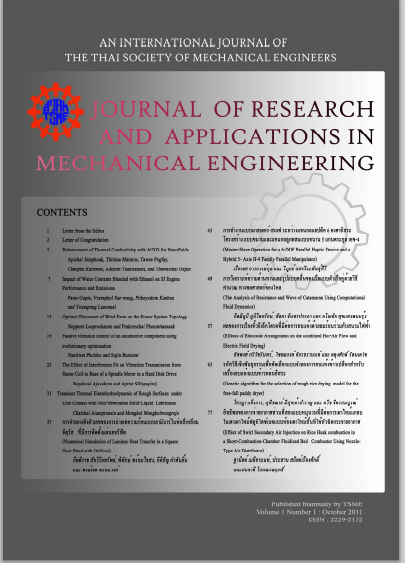Novel boundary conditions for turbulent flows enclosed by porous media
Main Article Content
Abstract
In this paper we present the new boundary conditions for the turbulent flows enclosed by porous medium. Such flows play a crucial role in many areas such as filters, oil wells, heat exchangers, catalytic reactors, ground water pollution, scouring and deposition of pollutions at river bed. Since the porous media always consist of multi-scale structures starting from the dimension of the porous medium itself down to pore scale. Resolving all of these structures is too expensive considering the uncertainty of the porous media geometry representation. Under certain conditions, the effects of the porous media to the turbulent flows can be modeled as boundary conditions. However, the approach adopted in [1], [2] and [3] lacks some physical property of the flow at the porous media interface because in those works, either the slip velocity or the interface-normal velocity is assumed zero. The boundary conditions proposed in this work, are validated against the pore scaled simulation in which the whole porous media are resolved. The proposed boundary conditions deliver excellent normalized mean velocity and fluctuations. The numerical simulation using boundary conditions only uses 0.92 Million grid cells and it is computed on a simple workstation compared to 230 Million grid cells of the pore scaled simulation which is computed on a cluster with 512 nodes. The proposed boundary conditions allow accurate predictions of such flows to be accessible by the computing resources available in Thailand.
Article Details
This work is licensed under a Creative Commons Attribution-NonCommercial-ShareAlike 4.0 International License.
References
[2] S. Hahn, J. Je, and H. Choi, Journal of Fluid Mechanics (2002). vol.450, pp. 259
[3] C. Wagner and R. Friedrich, Intl. Jour. of Heat and Fluid Flow (2002). vol.21(5), pp. 489
[4] S. Whitaker (1996), The Method of Volume Averaging, Springer Verlag.
[5] G. S. Beavers and D. D. Joseph, Boundary conditions at a naturally permeable wall, Journal of Fluid Mechanics Digital Archive (1967). vol.30
[6] P. Saffman, On the boundary condition at the surface of a porous medium, Stud. Appl.Math.(1971). vol.50(93).
[7] S. Whitaker, Flow in porous media I: A theoretical derivation of Darcy's law, Transport in Porous Media (1986). vol.1(3).
[8] M. Sahraoui and M. Kaviany, Slip and no-slip temperature boundary conditions at the interface of porous, plain media: Convection, International Journal of Heat and Mass Transfer (1994). vol.37, pp.1029.
[9] S. Whitaker, The Forchheimer equation: A theoretical development, Transport in Porous Media (1996). Vol.25(27).
[10] A. Shvidchenko. and G. Pender, Macroturbulent structure ofopen-channel ow over gravely beds, Water Resource Research (2001). vol.37, pp.709.
[11] D. Pokrajac, C. Manes, and I. McEwan, Peculiar mean velocity profiles within a porous bed of an open channel, Physics of Fluids (2007). vol.19, pp. 098109.
[12] Moser, Kim, and Mansour, Direct numerical simulation of turbulent channel flow up to Re=590, Physics of Fluids (1999). vol.11,pp. 943.
[13] W. P. Breugem, B. J. Boersma, and R. E. Uittenbogaard, The influence of wall permeability on turbulent channel flow, Journal of Fluid Mechanics (2006). vol.562, pp.35.
[14] K. Bhaganagar, J. Kim, and G. Coleman, Eect of Roughness on Wall-Bounded Turbulence Flow, Turbulence and Combustion (2004). vol.72, pp. 463
[15] T. Ikeda and P. A. Durbin, Direct simulations of a rough-wall channel flow, Journal of Fluid Mechanics (2007). vol.571, pp.235.
[16] O. Coceal, A. Dobre, T. G. Thomas, and S. E. BELCHER, Structure of turbulent flow over regular arrays of cubical roughness, Journal of Fluid Mechanics (2007). vol.589, pp.375.
[17] J. Ferziger and M. Peric, Computational Methods for Fluid Dynamics, Springer, 1996.
[18] M. Manhart, F. Tremblay, and R. Friedrich., Direct and large-eddy simulation of flow around a circular cylinder at subcritical Reynolds numbers, PhD thesis, Fachgebiet Strmungsmechanik, Technischen Universitt Mnchen, 2001.
[19] N. Peller, A. L. Duc, F. Tremblay, and M. Manhart,High-order stable interpolations for immersed boundary methods, International Journal for Numerical Methods in Fluids (2006)., vol.52, pp. 1175
[20] J. Gradl, H.-C. Schwarzer, F. Schwertfirm, M. Manhart, and W. Peukert, Precipitation of nanoparticles in a T-mixer: Coupling the particle population dynamics with hydrodynamics through direct numerical simulation, Chemical Engineering and Processing (2006). vol.45, pp.908.
[21] H. A. Khaledi, V. D. Narasimhamurthy, and H. I. Andersson, Cellular vortex shedding in the wake of a tapered plate at low Reynolds umber, Physics of Fluids (2009).vol. 21, pp.013603.



